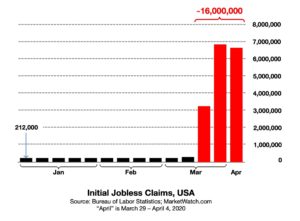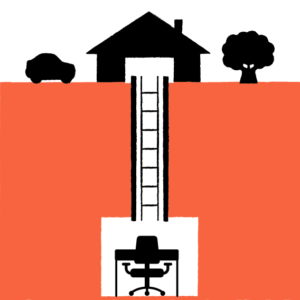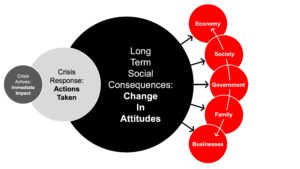 Prelude
Prelude
As the tragedy of Covid-19 continues, the images above and below depict utterly bizarre realities about today’s economy in an astonishing juxtaposition.
Look closely below and notice that as CNBC’s Jim Cramer celebrates the “The Dow’s Best Week Since 1938,” he seems entirely unaware that streaming across the screen below his face is a much different reality, the fastest and most brutal decimation of American employment in history. Why is the Dow up so brilliantly while unemployment is also soaring?

There’s a disconnect here, a big one, and we need to sort it out.
Or, to say it differently, this is our Covid moment. So what’s next? That’s what we will examine here in the second thought experiment in this series.
•••
On March 26, InnovationLabs published a detailed white paper that applied the scenario planning technique to consider how the Covid crisis may play out over the next few months and beyond.
The response to the white paper was exceptionally positive, and it found a readership far larger than we had expected. One thing we did expect, though, was that the situation would evolve rapidly, and so it has. During the three weeks since we published it, many of the questions that we raised in that white paper have already been answered.
Among these is one critically important factor, as it’s now clear is that we’re not going back to the way things were before. The “old normal,” that is, is permanently gone. Hence, this paper is entitled “The Next Normal,” based on the premise that while we’re not going back to how things were, the way things are going to be isn’t going to be permanent either: we’re entering a period of flux.
And thus the purpose of this follow-up report is to help us understand what’s that “next normal” might be.
It is important to note that we are aware that although we look at evidence from many nations, this paper takes an American perspective on the crisis, but it also seems that the choices and issues are nearly the same everywhere: what’s going to happen now, how will this end, and what comes after that.
Many readers kindly shared their thoughts and ideas on the first paper with us, and we list them here as contributors to this follow-up, as their ideas and suggestions have strongly influenced our thinking. We greatly appreciate their feedback, and we welcome yours as well.
White Paper Contents
Highlights: Executive Summary
- Some Basic Statistics
- A Model of Change
- The Economy: How Do You Cope with a Depression?
- Society: How Do You Rebuild Trust?
- Government: What Is Its Role Now?
- Your Family: What’s Next?
- Your Business: Survival Mode, Or, How Do You Restart?
- Conclusions & Recommendations
Appendix 1: Scenario Planning Summary
Appendix 2: The Politics of Crisis
Appendix 3: Resources
Please click here to go to the page where you may download the white paper.
Highlights: Executive Summary
Building on the previous white paper, we here consider the impacts of the Covid crisis at five levels of focus: the economy, society, government, the family, and business. Looking at them individually reveals some important insights for leaders to consider as they think about and plan for the post-Covid world.
Among the key insights is the likelihood that we are heading into a possibly severe depression with much deeper impact than a mere recession would bring. Although a depression is not a certainty, it is such a strong possibility that it is imperative to plan as if it is going to occur, and then be happily surprised if we avoid it. This will obviously have long-term repercussions.
Looking at society’s response to the crisis brings forth the theme of trust, in that all responses to Covid have to do with the absence of trust. Lockdown, after all, is the choice we make when have to assume that as anyone may be carrying the virus, we cannot trust anyone. How and how much trust returns to society will mark a major turning point.
Governments around the world have responded in many different ways, and they will surely be judged according to the how good or bad their recommendations and directives turn out to be.
Families, meanwhile, are under severe pressures now, as millions have abruptly been put out of work, and of course all of this has profound impact for business. At the more superficial level, we’re in the “Zoom Era” now, with renewed focus on remote work, and this will have enduring influence.
At a more fundamental level, the immediate issues brought forth by the crisis, as well as the longer-term implications, suggest that the macro economy itself is now in the midst of a transformative process, and the only thing a business can do is to go along and engage in its own process of transformation as well.
This is by no means an easy thing to understand or to accomplish, but it seems to be the emergent necessity for those that wish to survive and thrive in the times ahead. Transformation means thinking deeply about how work is organized as well as who customers are and what needs they may have. It means innovating new products, services, and business models while also engineering how systems operate.
When we started writing the report we didn’t know exactly where the trail of ideas and concepts would lead, and of course that’s exactly the point of doing a thought experiment, and that’s exactly why we wrote this paper as well as the previous one. And where we ended up, somewhat to our surprise, is in recognizing the great opportunity that the crisis has presented us with.
While we believe that the global economy was already in the early stages of a major transformation, a topic we’ve covered in our last few books, we realized that the Covid crisis is amplifying and accelerating this basic trend. Transformation, that is, is apparently inevitable, but Covid has brought forth many awarenesses and possibilities that did not previously exist. It has cleared the air (literally), shifted our perceptions of the role of government, and brought forth an abundance of creativity and social responsibility, all of which we can now build upon as we engage in transformation not merely to restore the economy, but to create a better one.
This is not to discount or diminish the loss of life, fear, and financial calamities in any way, but to identify what good can be made of them, and how they can help us to facilitate a better future.
1.
Some Basic Statistics
If the magnitude of what we are now facing is not yet apparent, please consider a few data points. While we could easily spend all day (and night) looking at stats and graphics, we’ve selected just a few highlights (or lowlights) to focus on.
Unemployment
“Moody’s Analytics calculates that more than 30 million American jobs are highly vulnerable to closures associated with Covid-19. Research published by the Federal Reserve Bank of St. Louis suggests that close to 50 million Americans could lose their jobs in the second quarter of 2020, pushing the unemployment rate about 30%.” Those are Depression-level job loss statistics.
The Economist. “Trough to peak.” April 4, 2020.
 Airlines
Airlines
“According to multiple metrics, the number of airline passengers has dropped by about 96%. On April 8, the TSA screened about 95,000 people at its airport checkpoints, as compared with 2.3 million a year previously. About one seat in ten is occupied on U.S. domestic flights, and U.S. airlines have taken 1800 planes out of use, parking them at various airports around the country.”
Gregory Wallace. CNN. “Airlines and TSA report 96% drop in air travel.” April 9, 2020.
“Analysts at Citigroup estimate that Delta Airlines is losing about $50 million per day. Automaker Volkswagen says it is losing €2 billion per week.”
The Economist. “Great white night.” April 4, 2020.
The Economy
“According to economists at J.P. Morgan, the U.S. economy collapsed at an annual rate of 40% during March. RBC, Canada’s largest bank, has identified five different scenarios describing how the virus may play out in the economy, but the uncertainties are so great that the most likely of the scenarios has only have a 35% probability of being correct. In other words, they just don’t know. Because no one knows. Further, as Dr. Anthony Fauci, Director of the National Institute of Allergy and Infectious Diseases has commented, ‘You don’t make the timeline, the virus makes the timeline.’”
Randall W. Forsyth. Barron’s. “Here’s How Bad the Economy Will Get — and How Quickly It Could Revive.” April 10, 2020.
“The biggest business handout in history has begun. At least $8 trillion of state loans and goodies have been promised to private firms in America and Europe, roughly equivalent to all their profits over the last two years. More than half a million European firms have applied for payroll subsidies.
The Economist. “Bottomless Pit, Inc.” April 4, 2019
Lockdown & Labor
When India announced a national lockdown on March 24 for the entire nation of 1.2 billion people, it immediately shut down rail, road, and air transport. Upon which about 600,000 people began the long walk from their precarious employments back home to their villages. But the government then stopped that exodus as well, reasoning that it would only spread the virus that the lockdown was designed to halt. The migrant waves were thus forced to stay wherever they were, and having no work and no means therefore to feed themselves, the state government of Delhi, India, for example, finds itself obliged to provide free food for 1 million people per day.
The Economist. “Under pressure.” April 4, 2020.
There is a massive labor shortage throughout the farming regions of Europe as the migrant labor force that normally does the harvesting is unable to travel to the farms. 300,000 workers are needed in Germany, and another 200,000 in France for the strawberry harvest alone. Polish workers normally migrate to Germany, and Ukrainians to Poland, but neither is able to move now. Consequently, local citizens are being actively recruited for the harvest, and many labor rules and laws are being relaxed to facilitate this. For instance, in France those living in migrant camps, and who are normally shunned, are being encouraged to join in, and farm earnings for unemployed French citizens that would normally cause an automatic reduction in social supports are now permitted.
The Economist. “Farmhands needed.” April 4, 2020.
There are plenty more indicators to consider, but these covey the outlines clearly enough. Everything, in other words, has changed.
But is it temporary? We don’t think so, as we will now explain.
2.
A Model of Change
In the previous white paper, we applied the scenario planning approach to consider many possible futures. We noted in that paper that scenario planning is a multi-step thinking process: First you identify the forces driving change; next, you develop multiple scenarios of what may occur by considering the interaction of those forces; and then you note any observations that cut across the multiple scenarios. As a final step you identify any imperatives for your organization based your observations. These imperatives are things you must do regardless of how you think things are going to turn out.
And after that, while you implement the imperatives, you also watch closely to see what happens. Because your brain has been sensitized through the thought experiment process of crafting scenarios, you’re often able to recognize the importance of key events and trends that you might otherwise have missed. That is, you begin to notice early warning indicators which suggest how things are starting to go.
These are called “Leading Indicators,” and they are often powerful insights that will help you to further improve your imperatives action plan, because they provide evidence of what’s happening so you can course correct. You compare the evidence with your expectations, and quickly make adjustments, and all this occurs on an accelerated time scale because you are mentally prepared.

In addition, in the Covid Scenario Planning White Paper we put forth a model which suggests that a crisis such as Covid provokes change at three levels. When the crisis first arrives there is an immediate emergency impact, which then leads to actions, and then eventually the long term social consequences become apparent. These are often changes in attitudes and they can be the most impactful, and hence they are represented by largest circle.
While only three weeks have passed since we wrote the first paper, we’re highly sensitized to change and we are indeed already starting to see important leading indicators, early warning signs of what the future may hold.
Hence, in this paper we take the leap from considering scenarios of what might occur, to looking more deeply at impacts that are now emerging and possibly even evident, as we are extrapolating from these to consider what the future may hold.
Please note that the purpose here, as with the previous paper, is not necessarily to accurately predict what’s coming, but instead to provide useful thought stimulators that may help you to get clear about what you’re seeing, what you need to prepare for, and the actions you need to take.
Five Dimensions of Change
Broadly, as the impacts and consequences unfold we can already see implications emerging in five dimensions:
- The Economy
- Society
- Government,
- Your Family, and
- Your Business.
These five are intimately connected with one another, and the connections between them contribute to the sense of complexity and the feeling of overwhelm that is now common for many of us of. Everything is happening at once, and much of it is frightening.
We’ll look at some of those connections in the Conclusion of this paper, but first we’ll take a look at the five as though they were separate and distinct domains. While we know they’re not really separate, looking at them individually will nevertheless help us to see some important trends and patterns.

And so the white paper continues on for quite a few pages with detailed discussions of each of these five topics, a great many relevant quotes from various news sources, and then concludes with a discussion of two major recommendations:
- Prepare for the worst, a depression.
- Prepare also for a transformation of the global economy, which will in turn require a transformation of your own enterprise.
Please click here to go to the page where you may download the white paper.

•••
As always, we welcome your comments and feedback.
Please contact us at LMorris@innovationlabs.com


